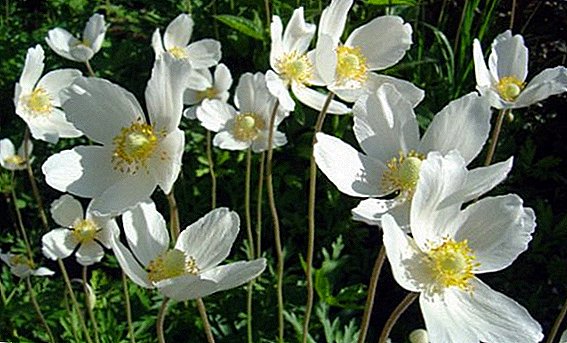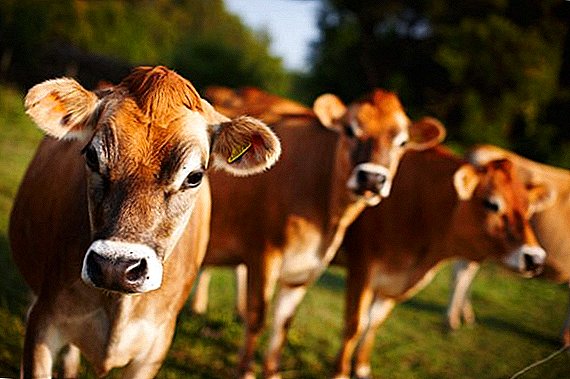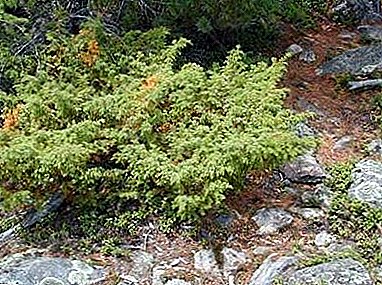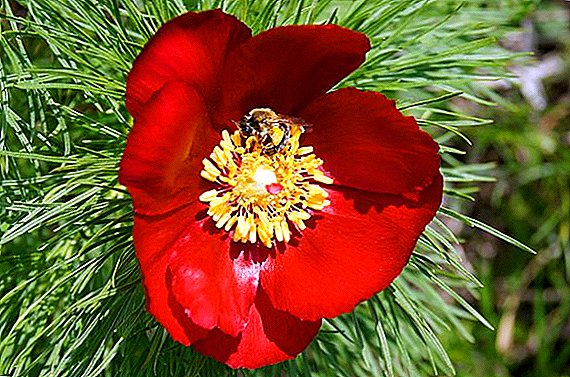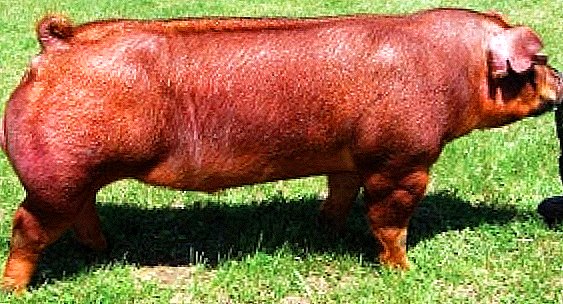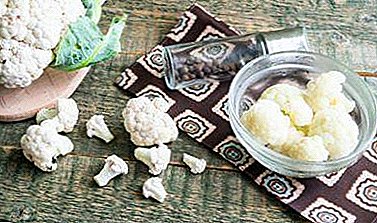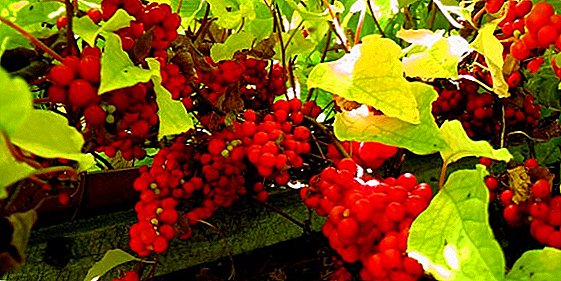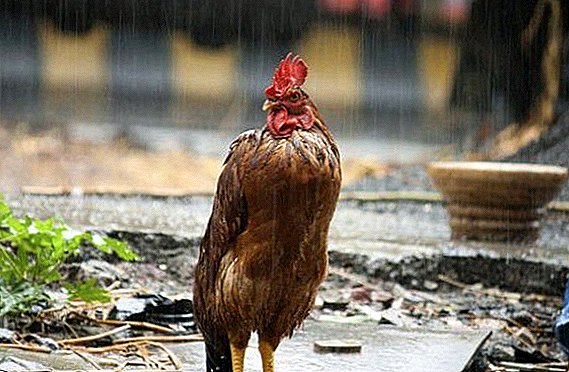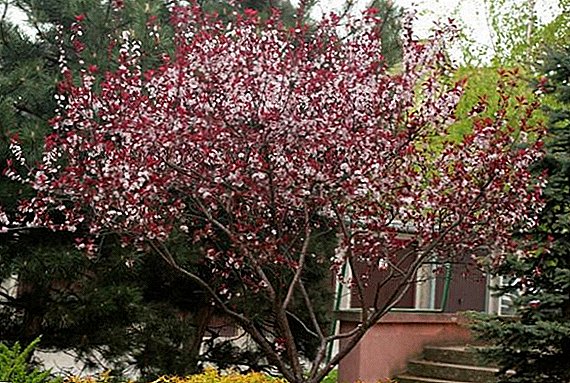 Plum is not just a plant whose fruits have an amazing taste and are an excellent raw material for making fragrant jam for the winter. It can also perform decorative functions and serve as an element of excellent landscape design. Especially if it is a red leaf plum "Pissardi".
Plum is not just a plant whose fruits have an amazing taste and are an excellent raw material for making fragrant jam for the winter. It can also perform decorative functions and serve as an element of excellent landscape design. Especially if it is a red leaf plum "Pissardi".
This type attracts the attention of the original flowering and leaf color, which will give a special flavor to the garden plot, cottage, park or lawn. Let us consider in more detail what kind of tree it is, what is its value, how to grow it and how to care for it.
A bit of history
Variety "Pissardi" known among gardeners as a cherry, sprawling plum, cherry plum. Culture is a member of the Rosaceae family. 
Did you know? The epithet "cherry" appeared due to the fact that the fruits of the plant resemble cherries in shape, but they are slightly larger. As for the name "plum", it is also associated with the shape of the fruit, but here it is the size that is the basis.
In the wild, the plant is common in Abkhazia, Ajaria and western Georgia, the mountainous environs of Western Asia. The place of her birth is Iran. For the first time, the leading French botanist Eli-Abel Carrie spoke about red cherry plum.
The family also includes Japanese carrion, gravilat, field soldier, Volzhanka, Potentilla Norwegian, hawthorn, dog rose, spiraea.The plum "Pissardi" got its name in honor of the botanist Pissard, who first brought it to Europe (or rather, to Paris) in 1878 from Iran. In Iran, this species has been cultivated since ancient times.
Characteristics and description of the variety
The appearance of the culture makes it easily recognizable among other varieties. Let us consider in more detail the features of such a garden pupil. 
Tree
Cherry plum grows as an ornamental shrub that is grafted on a slender trunk. The magnificent sprawling dense krone of a tree draws attention. It is formed by reddish young shoots covered with smooth dark bark. The short barrel is brown.
Important! The average height of the tree is from 5 to 9 meters. The maximum height indicator is 12 meters. During the year the length of the shoots increases by 20-25 cm.
The shape of the leaves of the plant is similar to an ellipse. They catch the eye with purple or red color and metallic luster. Leaves are arranged alternately. The color of the foliage is unchanged throughout the growing season. The length of the sheet - from 4 to 6 centimeters.
Are the fruits edible?
The grade "Pissardi" differs in plentiful fructification. Fruits are juicy dark-colored pitted trees. 
The diameter of one such fruit is 3 cm, and its weight varies between 20-30 g. In the center of the fruit is a bone of elongated and oval shape. The fruits ripen in August and keep on the tree until October. Color cream - red and maroon.
Edible cream, but not every gourmet will decide to eat it: they are sour and tart.
Learn about the cultivation of such varieties of edible plums as "President", "Mirabelle", "Bogatyrskaya", "Anna Shpet", "Honey White", Hungarian plums, Chinese plums, peach plums.
But, despite this unattractive taste, the fruits of cherry plum, like other plum trees, are full of many macro-and microelements useful for the body.
Important! Cream "Pissardi" mainly used for medical purposes. Their use helps purify the blood and eliminate toxins from the human body. Also, the use of plums increases appetite, improves heart and kidney function. The fruits are used in cosmetology for the manufacture of anti-aging masks and scrubs.

Bloom
Red plum blossom in April. The plant is covered with five-petal flowers even before the leaves appear. The flowering process ends in May, already with foliage. The flowers are painted in pale pink color and bloom on light pink pedicels.
In May, at the end of flowering, the flowers become dark red color. Their stamens have a bright crimson color. The diameter of the flower is 2.5 cm. The flowers have not only an attractive appearance, but also an amazingly pleasant aroma.
Drought resistance and frost resistance
Optimum climatic conditions for "Pissardi" - moderate. Culture tolerates drought, but does not like a surplus of moisture. It is not recommended to land near the sea.
Important! When planting cherry plum must take into account the fact that it is not frost resistant. The tree painfully tolerates low temperatures. It is recommended to plant it in warm, sunny areas.

Growing conditions
Red garden beauty prefers well-drained soil, slightly acidified or alkaline. The best type of soil for culture is sandy-argillaceous. Also, the soil should be fertile and loose.
It is recommended to plant it in warm, sunny areas, protected from piercing winds and drafts, but with good air circulation. The tree feels best in the southern regions.
Application in landscape design
Due to the original color of the foliage, the Pissardi variety is widely used in landscape design to create landscape compositions as a contrast plant. On a green background, culture looks particularly impressive.
This variety is widely used for landscaping the city, oriental-style gardens, creating landscape color compositions and avenues. 
"Pissardi" - an integral component of single and group plantings. Especially attractive cherry plum looks in compositions with acacia and cypress.
Landing rules
Planting splayed plum is best done in the spring, until the buds swell. It is also possible to plant in the fall, until the first frosts come. The optimum spring time is April, autumn is mid-September.
Did you know? The life of the tree "Pissardi" lasts an average of 100 years.
Plums are planted in the southern part of the site. Experienced gardeners generally recommend planting a crop separately from other plants, as it does not like the neighborhood.
When planting, it is important to consider the level of groundwater occurrence. It is recommended to plant the plant on the site where this level is not less than 1.5 meters. If the groundwater is closer, then the bottom of the landing hole must be drained with expanded clay or other available materials. 
Preparation of the landing pit itself should be carried out two weeks before planting a tree. The depth of the hole should be 50 cm, width - 70 cm. The bottom of the fossa of the required size is covered with substrate from fertile soil and humus. After that, you need to install a landing pin.
On the north side of the cola, the seedling is placed so as to position the root collar 3-5 cm higher from the ground level. After placing the seedling in the hole, its root system needs to be powdered with a fertile substrate. Pit fall asleep and lightly tamped.
The final touch of the planting stage is to tie the seedling to the peg, water it abundantly and mulch the soil. 
Important! The distance between the seedlings of this culture should be 2 meters. Between the seedling and other plants - so that the "neighbors" do not shade the young plum tree. Therefore, it is necessary to calculate the distance, starting from the height of the neighboring crops.
Care features
Red plum unpretentious care. Successful care of this variety is practically no different from the care of other leafy ornamental plants. But culture has its own preferences.
Watering
Despite the fact that the Pissardi variety is hardy to drought, it requires regular abundant watering. The culture is watered once a week. One tree will need 4-6 buckets of water.
Top dressing
In the first year after planting, it is not recommended to fertilize a young plant. Top dressing is carried out in the second year of the tree's vital activity.
In the spring, the plum needs potash fertilizers and sodium humate, and in the fall gardeners are advised to apply humus (half a bucket of fertilizer / 1m² of land). 
Also in the springtime it is recommended to “feed” the red leaf plum with nitrogen fertilizers, in the summer - phosphate fertilizers, and in the fall - potash fertilizers.
To potassium fertilizers include such as potassium monophosphate, "Kalimagneziya", potassium chloride, potassium nitrate, "Kalimag", potassium sulfate.
Soil care
Do not neglect the care of the soil around the tree:
- Regularly remove weeds around the trunk of the plant.
- Mulching cherry plum advised to hold in the spring and autumn. Spring mulching is carried out to ensure that the growth zone of the roots warms up and begins to work actively (to feed on nutrients from the soil). In the quality of mulch using rotted manure or compost. Mulching splayed plum in the fall should be with the onset of the first frost. This is done to protect the roots of heat-loving plants from frost.
- Removal of weeds is accompanied by timely loosening of the soil. This is necessary so that the roots receive enough oxygen.
Important! The red leaf plum has a superficial root system, therefore oxygen is necessary for its normal vital activity.

Pruning branches and shoots
The grade "Pissardi" perfectly transfers both forming (for giving to a tree of a decorative form), and sanitary cutting. And the one and the other spend the spring. Sanitary pruning is to remove dry, diseased or damaged branches.
Learn about the main nuances of pruning.
Also, during sanitary pruning, excess shoots are removed, which prevent the crop from getting enough sunlight. If the plant is sick, sanitary pruning is carried out regardless of the season, in order to remove diseased branches and save the tree.
"Pissardi" on the shtambe does not need a forming trim. But it is recommended to remove each new growth in order to preserve the shape. 
Preparing for the winter
Cherry-cherry plum is a thermophilic plant, so it must be carefully prepared for winter. The main measures for preparing the culture for the winter is abundant watering and mulching. It is also necessary to cover the trunk of the plum tree with peat (straw).
Advantages and disadvantages
You can not talk about plum "Pissardi", without mentioning its strengths and weaknesses.
Let's start with the best:
- plum "Pissardi", due to its unique appearance and early flowering, is a wonderful decoration of the landscape. It possesses high decorative qualities and serves as a bright “necklace” of any part;
- the culture is not afraid of drought and gas pollution;
- cherry cherry plum endures attacks of many diseases;
- the grade is unpretentious in leaving, does not demand special attention to the "person".

The disadvantages include:
- fear of winds, drafts, frost and cold;
- cherry plum fruits are not distinguished by good taste, so the tree is not so much fruit as decorative;
- the plant does not tolerate neighbors and requires a lot of space.
As you can see, decorating your own garden, cottage or lawn is pretty easy. You just need to plant a colorful plum "Pissardi". Such a bright culture with its purple contrasting look will help not only to create the perfect landscape design, but also to decorate everyday life. Moreover, it will not be difficult to care for such a pupil.


